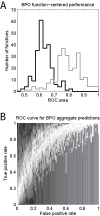Characterizing the state of the art in the computational assignment of gene function: lessons from the first critical assessment of functional annotation (CAFA)
- PMID: 23630983
- PMCID: PMC3633048
- DOI: 10.1186/1471-2105-14-s3-s15
Characterizing the state of the art in the computational assignment of gene function: lessons from the first critical assessment of functional annotation (CAFA)
Abstract
The assignment of gene function remains a difficult but important task in computational biology. The establishment of the first Critical Assessment of Functional Annotation (CAFA) was aimed at increasing progress in the field. We present an independent analysis of the results of CAFA, aimed at identifying challenges in assessment and at understanding trends in prediction performance. We found that well-accepted methods based on sequence similarity (i.e., BLAST) have a dominant effect. Many of the most informative predictions turned out to be either recovering existing knowledge about sequence similarity or were "post-dictions" already documented in the literature. These results indicate that deep challenges remain in even defining the task of function assignment, with a particular difficulty posed by the problem of defining function in a way that is not dependent on either flawed gold standards or the input data itself. In particular, we suggest that using the Gene Ontology (or other similar systematizations of function) as a gold standard is unlikely to be the way forward.
Figures



References
Publication types
MeSH terms
Substances
Grants and funding
LinkOut - more resources
Full Text Sources
Other Literature Sources
Research Materials

